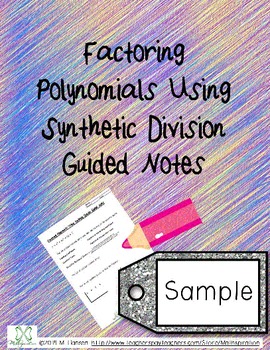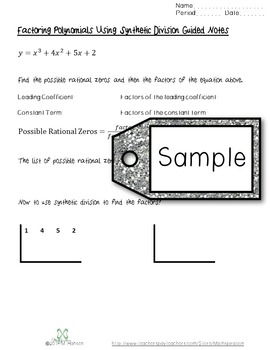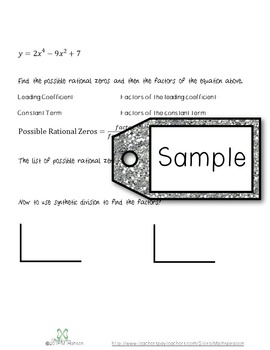Factoring Polynomials
Mathspiration
106 Followers
Grade Levels
9th - 12th, Higher Education, Adult Education, Homeschool
Subjects
Resource Type
Standards
CCSSHSF-IF.C.8
CCSSMP1
CCSSMP6
CCSSMP8
Formats Included
- PDF
Pages
7 pages
Mathspiration
106 Followers
Description
Factoring Polynomials Using Synthetic Division Guided Notes
These guided notes show students how to use synthetic division and possible rational zeros to find the complete factorization of a polynomial. There are seven pages of notes, three where the teacher shows some examples, and four with additional examples for students to try. These guided notes would be an excellent addition to any notes on synthetic division, factoring polynomials, or possible rational zeros.
Included are:
Teacher Instructions
Guided notes
_____________________________________________________
If you like this activity please view my other products in my Mathspiration store:
Test Correction Form
Bathroom Log
Circles: My Favorite No!
Area of a Sector and Arc Length
FOIL: Luck of the Draw
Combining Like Terms: Luck of the Draw
Function Operations: Luck of the Draw
Exponent Rules: My Favorite No!
_____________________________________________________
Earn TpT Credits!
You get one TpT Credit for every $ you spend on TpT. Every 100 Credits is worth $5 that you can apply towards future TpT purchases. They can really add up!
Here's how to do it:
My TpT ---> My Purchases ---> Provide Feedback (under product titles)
FOLLOW MY STORE
Here's how:
Visit my store ---> Click "Follow Me" under Mathspiration
These guided notes show students how to use synthetic division and possible rational zeros to find the complete factorization of a polynomial. There are seven pages of notes, three where the teacher shows some examples, and four with additional examples for students to try. These guided notes would be an excellent addition to any notes on synthetic division, factoring polynomials, or possible rational zeros.
Included are:
Teacher Instructions
Guided notes
_____________________________________________________
If you like this activity please view my other products in my Mathspiration store:
Test Correction Form
Bathroom Log
Circles: My Favorite No!
Area of a Sector and Arc Length
FOIL: Luck of the Draw
Combining Like Terms: Luck of the Draw
Function Operations: Luck of the Draw
Exponent Rules: My Favorite No!
_____________________________________________________
Earn TpT Credits!
You get one TpT Credit for every $ you spend on TpT. Every 100 Credits is worth $5 that you can apply towards future TpT purchases. They can really add up!
Here's how to do it:
My TpT ---> My Purchases ---> Provide Feedback (under product titles)
FOLLOW MY STORE
Here's how:
Visit my store ---> Click "Follow Me" under Mathspiration
Total Pages
7 pages
Answer Key
Rubric only
Teaching Duration
30 minutes
Report this resource to TPT
Reported resources will be reviewed by our team. Report this resource to let us know if this resource violates TPT’s content guidelines.
Standards
to see state-specific standards (only available in the US).
CCSSHSF-IF.C.8
Write a function defined by an expression in different but equivalent forms to reveal and explain different properties of the function.
CCSSMP1
Make sense of problems and persevere in solving them. Mathematically proficient students start by explaining to themselves the meaning of a problem and looking for entry points to its solution. They analyze givens, constraints, relationships, and goals. They make conjectures about the form and meaning of the solution and plan a solution pathway rather than simply jumping into a solution attempt. They consider analogous problems, and try special cases and simpler forms of the original problem in order to gain insight into its solution. They monitor and evaluate their progress and change course if necessary. Older students might, depending on the context of the problem, transform algebraic expressions or change the viewing window on their graphing calculator to get the information they need. Mathematically proficient students can explain correspondences between equations, verbal descriptions, tables, and graphs or draw diagrams of important features and relationships, graph data, and search for regularity or trends. Younger students might rely on using concrete objects or pictures to help conceptualize and solve a problem. Mathematically proficient students check their answers to problems using a different method, and they continually ask themselves, "Does this make sense?" They can understand the approaches of others to solving complex problems and identify correspondences between different approaches.
CCSSMP6
Attend to precision. Mathematically proficient students try to communicate precisely to others. They try to use clear definitions in discussion with others and in their own reasoning. They state the meaning of the symbols they choose, including using the equal sign consistently and appropriately. They are careful about specifying units of measure, and labeling axes to clarify the correspondence with quantities in a problem. They calculate accurately and efficiently, express numerical answers with a degree of precision appropriate for the problem context. In the elementary grades, students give carefully formulated explanations to each other. By the time they reach high school they have learned to examine claims and make explicit use of definitions.
CCSSMP8
Look for and express regularity in repeated reasoning. Mathematically proficient students notice if calculations are repeated, and look both for general methods and for shortcuts. Upper elementary students might notice when dividing 25 by 11 that they are repeating the same calculations over and over again, and conclude they have a repeating decimal. By paying attention to the calculation of slope as they repeatedly check whether points are on the line through (1, 2) with slope 3, middle school students might abstract the equation (𝑦 – 2)/(𝑥 – 1) = 3. Noticing the regularity in the way terms cancel when expanding (𝑥 – 1)(𝑥 + 1), (𝑥 – 1)(𝑥² + 𝑥 + 1), and (𝑥 – 1)(𝑥³ + 𝑥² + 𝑥 + 1) might lead them to the general formula for the sum of a geometric series. As they work to solve a problem, mathematically proficient students maintain oversight of the process, while attending to the details. They continually evaluate the reasonableness of their intermediate results.





